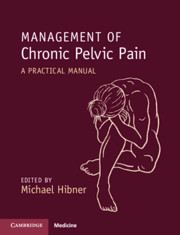Book contents
- Management of Chronic Pelvic Pain
- Management of Chronic Pelvic Pain
- Copyright page
- Contents
- Contributors
- Foreword
- Chapter 1 Introduction to Chronic Pelvic Pain
- Chapter 2 Neurobiological Basis of Pelvic Pain
- Chapter 3 History and Evaluation of Patients with Chronic Pelvic Pain
- Chapter 4 Psychological Assessment of a Female Patient with Chronic Pelvic Pain
- Chapter 5 Musculoskeletal Assessment for Patients with Pelvic Pain
- Chapter 6 Pharmacological Management of Patients with Pelvic Pain
- Chapter 7 Evidence for Surgery for Pelvic Pain
- Chapter 8 Pelvic Pain Arising from Endometriosis
- Chapter 9 Bladder Pain Syndrome
- Chapter 10 Pelvic Pain Arising from Pelvic Congestion Syndrome
- Chapter 11 Irritable Bowel Syndrome
- Chapter 12 Vulvodynia
- Chapter 13 Pelvic Pain Arising from Adhesive Disease
- Chapter 14 Pelvic Pain Arising from Ovarian Remnant Syndrome
- Chapter 15 Pudendal Neuralgia
- Chapter 16 Other Peripheral Pelvic Neuralgias
- Chapter 17 Chronic Pain After Gynecological Surgery
- Chapter 18 Pain Arising from Pelvic Mesh Implants
- Chapter 19 Treatment of Sexual Dysfunction Arising from Chronic Pelvic Pain
- Chapter 20 Physical Therapy Interventions for Musculoskeletal Impairments in Pelvic Pain
- Chapter 21 If Everything Else Fails
- Index
- References
Chapter 2 - Neurobiological Basis of Pelvic Pain
Published online by Cambridge University Press: 08 March 2021
- Management of Chronic Pelvic Pain
- Management of Chronic Pelvic Pain
- Copyright page
- Contents
- Contributors
- Foreword
- Chapter 1 Introduction to Chronic Pelvic Pain
- Chapter 2 Neurobiological Basis of Pelvic Pain
- Chapter 3 History and Evaluation of Patients with Chronic Pelvic Pain
- Chapter 4 Psychological Assessment of a Female Patient with Chronic Pelvic Pain
- Chapter 5 Musculoskeletal Assessment for Patients with Pelvic Pain
- Chapter 6 Pharmacological Management of Patients with Pelvic Pain
- Chapter 7 Evidence for Surgery for Pelvic Pain
- Chapter 8 Pelvic Pain Arising from Endometriosis
- Chapter 9 Bladder Pain Syndrome
- Chapter 10 Pelvic Pain Arising from Pelvic Congestion Syndrome
- Chapter 11 Irritable Bowel Syndrome
- Chapter 12 Vulvodynia
- Chapter 13 Pelvic Pain Arising from Adhesive Disease
- Chapter 14 Pelvic Pain Arising from Ovarian Remnant Syndrome
- Chapter 15 Pudendal Neuralgia
- Chapter 16 Other Peripheral Pelvic Neuralgias
- Chapter 17 Chronic Pain After Gynecological Surgery
- Chapter 18 Pain Arising from Pelvic Mesh Implants
- Chapter 19 Treatment of Sexual Dysfunction Arising from Chronic Pelvic Pain
- Chapter 20 Physical Therapy Interventions for Musculoskeletal Impairments in Pelvic Pain
- Chapter 21 If Everything Else Fails
- Index
- References
Summary
Nerve pain is more often than not a cause of pelvic pain. This is particularly true in patients in whom pain started after pelvic trauma, surgery, or vaginal delivery. Unfortunately, most of gynecologists who are often physicians of primary contact for mesh patients are not trained in recognizing and treating patients with nerve injury pain. Patients with nerve injury pain can almost always pinpoint the moment when the pain started. It is often unilateral and neuropathic in nature. Patients have a burning, tingling sensation often associated with increased sensitivity to stimuli analogous to skin pain after sunburn. Pain is often exacerbated by body movements and certain body positions. It is very important for the first provider who sees patients with pelvic pain that pain may be related to nerve injury because expeditious treatment increases the chances of recovery. It is also important to instruct patients to avoid activity that started the pain in the first place and minimize activity that exacerbates the pain. Trial of muscle relaxants, gabapentin, or pregabalin may be appropriate first treatment; however, prompt referral to physical therapy, neurology, or a specialized pelvic pain center is often necessary.
- Type
- Chapter
- Information
- Management of Chronic Pelvic PainA Practical Manual, pp. 6 - 12Publisher: Cambridge University PressPrint publication year: 2021

